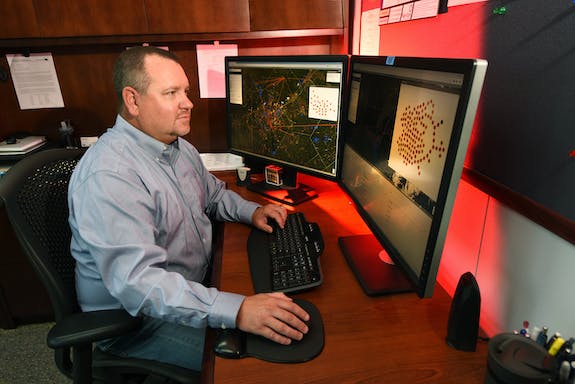Energy resilience is the mantra of a new generation of policy and research. How do we protect our infrastructure, industrial economy, and communities from disruptors? As American culture and industry move toward increasingly higher standards for energy security and reliability, it is becoming clear that no one solution will solve this problem for all industries and communities. Many solutions will be local solutions. For these to succeed, communities and companies large and small – all across the United States – will need the guidance of critical thinkers knowledgeable about the complexities of energy and infrastructure interdependence.
This spring, Boise State University and Idaho National Laboratory are building this capacity locally, by collaborating with Boise State Associate Professor Kathy Araújo’s new interdisciplinary course on the complexities of energy-related decision-making.
“Energy impacts so many aspects of our daily lives, yet most of us never had an energy course in school,” says the course’s instructor, Associate Professor Kathy Araújo. “As energy users, we should have a better sense of how the decisions relating to energy are being made and what trade-offs are being factored into those decisions.”
The new course, 21st Century Opportunities and Challenges in Energy – Strategic Decision-making about Systems Change, is a unique offering in problem-directed learning for 20 undergraduate and graduate students from four schools at Boise State. In a first-of-its-kind partnership between Boise State and INL’s Infrastructure Assurance and Analysis Group, the INL researchers have supplied students with cloud-based access to the All Hazards Analysis Framework (AHA), a specialized tool that INL has developed to guide research and policy decision-making.
AHA is a dynamic analytical framework that utilizes data about critical infrastructure to enable knowledge discovery and decision support. As the infrastructure changes, AHA is updated. The tool is used to simulate possible scenarios that might impact critical infrastructure, from natural disasters to addition of new equipment. It can identify interdependencies within the infrastructure systems and help decision-makers to understand how and where the infrastructure systems interrelate. In the past, the tool has been used in other INL research, and by state and federal government partners to guide policy decisions and to understand risk.

“The concept of resilience is important, not only to the electric grid, but to all of the other critical infrastructures that feed into the electric grid,” says INL researcher Ryan Hruska. “We are using AHA to look more holistically across our energy infrastructure and to learn where vulnerabilities in the system exist so that we can focus on mitigation before they become problems in the future.”
Using AHA, Boise State students are experimenting with real problems and real data impacting the energy sector today. By examining the actual trade-offs involved in energy decisions, students will refine and focus their critical thinking and energy systems analysis skills. The course’s interdisciplinary nature brings together perspectives from engineering, economics, policy, innovation and other fields, mirroring the multifaceted teams needed to solve energy challenges at regional, national and international levels.
At INL, dozens of researchers, analysts and developers have supported the development and operation of AHA over the past six years. INL staff Ryan Hruska and Kelly Wilson are working with the class to ensure that students have access and understanding of the capabilities that AHA offers for real-world problem-solving. Hruska provided a virtual introduction to the tool at the start of the term and Wilson visited the class on Feb. 5. She gave students an overview of the INL Resilience Optimization Center and presented case studies in energy resilience assessment produced by the U.S. Department of Homeland Security’s Regional Resilience Assessment Program. During her lecture, Wilson informed students about opportunities for internships, postdoctoral research, and careers at INL.

“Idaho National Laboratory is a spectacular place to work on energy resilience,” says Kelly Wilson, INL manager and analyst. “By sharing tools like AHA with Boise State and by bringing students and graduates to the lab for internships and careers, we are making sure they have the education and opportunities that they need to succeed in solving the energy problems of the future.”
Hruska and Wilson see this partnership as a pilot. They hope that success here will allow them to expand availability of AHA to education opportunities at other colleges and universities in the future. Energy resilience is a problem for the ages. Finding solutions that work requires critical thinkers who understand the interdependencies that impact possible solutions.
Perhaps Araújo put it best when she said, “Experiential learning is a critical component for understanding the complex and real-world interrelationships of the energy issues that we are facing.”
By providing real tools and direct interactions with researchers working in the area, researchers say this type of partnership is exactly what’s needed to support future solutions to America’s energy challenges.







